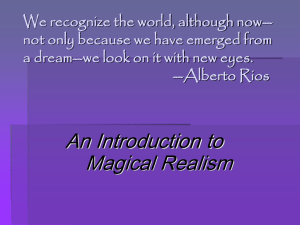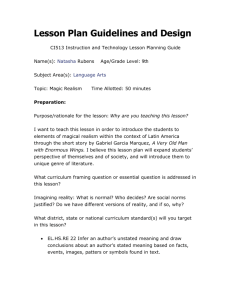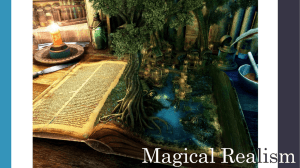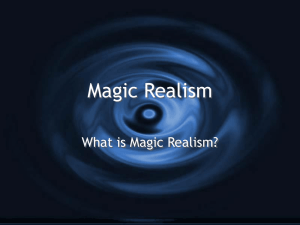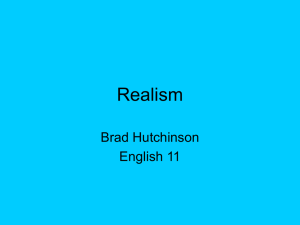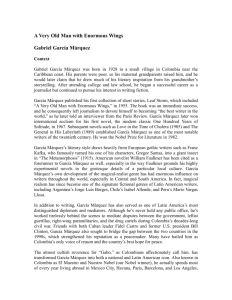Magic Realism - Mrs Ma`s English SMIC
advertisement
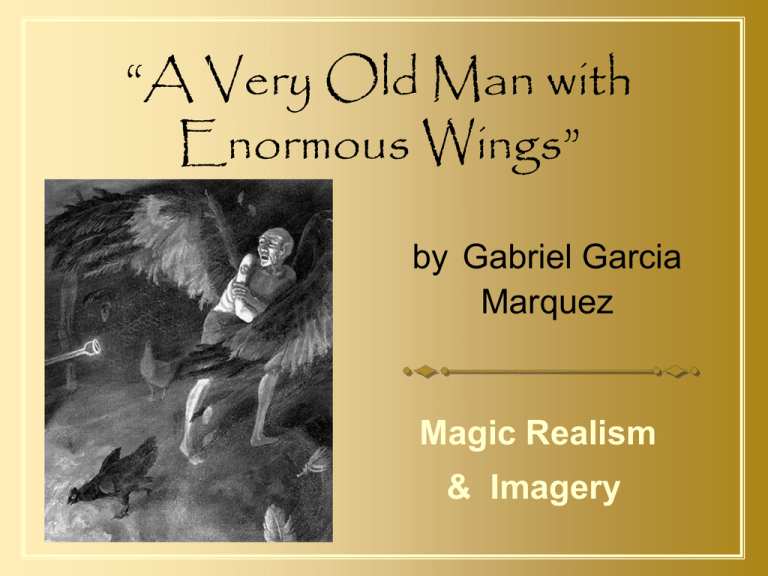
“A Very Old Man with Enormous Wings” by Gabriel Garcia Marquez Magic Realism & Imagery Opening: What was your initial reaction to the story? Did you like it? Thumb test. Let’s talk about it. 2 Author and Setting Gabriel Garcia Marquez, born in 1928 in Aracatuba, Colombia Won the Nobel Prize in Literature in 1982 Setting is in a small seaside village in South America 3 What genre is this? Short Story Magic Realism What you do already know about this genre? "Reality is not always probable, or likely." ----Jorge Luis Borges ---- 4 Definition The introduction of magical devices or magic in general within a believable (realistic) story, without any disruption of the logic of the story. Magic Realism is a literary style that "combines realistic, everyday details with elements of fantasy, blurring the reader's usual distinctions between reality and magic. But unlike other works of the imagination such as fairy tales or folk legends, stories of magic realism lead to no clear morals or simple truths; they present a rich and vivid world of magical possibilities, while frustrating and complicating the reader's efforts to fix a definite meaning to events” Also called "marvelous realism“ (Carpentier) Magical Realism vs Fantasy In fantastic literature, a new universe is introduced to the reader, with its laws (natural as well as artificial), its regularities, its objects, its people, its forces, etc. This world is completely different from ours, or has enough differences so that we (readers) need explanations to understand it correctly. Magic Realism vs Fantasy In magic realist literature, the world depicted is ours, with one major new component: magic is a possibility (and an actuality) within it. There shouldn’t be any need to explain what is going on in this world, its laws, its people, etc. We already know that since it is a fictional reproduction of our world. Magic Realism Elements of dreams, fairy tales, folklore, or mythology. Earthly, realistic settings. Laws of nature suspended. Realism combined with supernatural. Effect? Humorous and thought-provoking results. Angel Flores “In magical realism we find the transformation of the common and the everyday into the awesome and the unreal. It is predominantly an art of surprises. Time exists in a kind of timeless fluidity and the unreal happens as part of reality. Once the reader accepts the fait accompli, the rest follows with logical precision.” Richard Prehn/ZXORB Your Turn Do you see elements of magical realism in the text? b) What are the "magical possibilities" in this story? How is the supernatural mixed with the mundane? 10 Your Turn! With your group, Find three examples of magic realism in the story. Magic Realism Example #1 “He had to go very close to see that it was an old man, a very old man, lying face down in the mud, who, in spite of his tremendous efforts, couldn't get up, impeded by his enormous wings.” Magic Realism Example #2 “Against the judgment of the wise neighbor woman, for whom angels in those times were the fugitive survivors of a spiritual conspiracy, they did not have the heart to club him to death.” What literary devices does Marquez use? Symbolism Allusion Figurative language Imagery 14 Imagery Words or phrases that appeal to the senses. Most commonly appeals to sense of sight. Imagery Example #1 “Sea and sky were a single ash-gray thing and the sands of the beach, which on March nights glimmered like powdered light, had become a stew of mud and rotten shellfish.” Imagery Example #2 “Then he noticed that seen close up he was much too human: he had an unbearable smell of the outdoors, the back side of his wings was strewn with parasites and his main feathers had been mistreated by terrestrial winds, and nothing about him measured up to the proud dignity of angels.” Your Turn! • Find three examples of imagery in the story using the chart I will send home with you today. Language & Narration: Anything else interesting about the language? What do you think of the story's narrative? Is the narrator judgmental or sympathetic in any way? Speaker Who is the narrator? Who is the main character? Tone and Mood The mood of the story is very gloomy and dark What is the culture and time period of this text? The setting is in an unnamed coastal town, probably in South America. Happened sometime in the past although it doesn’t give many hints as to when. 20 Format The story is packaged as a fable. Its subtitle--"A Tale for Children"--underscores its fairy tale format. Define Satire. Also has a religious element in when the angel is flying away at the end, signifies faith. So is there a moral? Several are possible: People wouldn't recognize a miracle even if they saw one. Patience pays off. Appearances are deceptive. Types of Satire – from AP There are 2 basic forms of satire – Formal or Direct Satire Indirect Satire. Formal Satire is first person satire directed to the audience or another character in the text. Indirect Satire is expressed through narrative and is normally told in the 3rd person. It is derived from the actions of the characters. Direct Satire – from AP Formal or Direct Satire can be broken down into 2 basic types: Horatian and Juvenalian. Horatian Satire is gentle, urbane, smiling satire; it aims to correct by gentle, sympathetic laughter Juvenalian Satire is biting, bitter, and angry in tone. It points with contempt and moral indignation to the corruption and evil of human beings and institutions. A Very Old Man with Enormous Wings is a harsh cruel and gripping tale that shows how compassion is made more startling and significant when it is highlighted against such an existence of cruelty, abuse, and horrors. Gabriel Garcia Marquez a writer of deeply sorrowful epics helps us to remember that we should treat all well for we may be dealing with Angels or the Lord himself in disguise. The book [sic] A Very Old Man with Enormous Wings is fraught with symbolism. Wings are symbolic of unchecked freedom of motion and Angels and yet he chooses to stay with the family as an act of compassion to change their lives. The spider woman is atypical of many people’s pettiness, only when it’s easy and works in my favor to support my prejudices, and all too convenient "Faith". Gabriel Garcia Marquez's tale is as poignant now as it was when he wrote it. It shows humanity’s inhumanity toward each other based on looks, culture, faith, gender, race, creed, as the backdrop to highlight our moments of compassion towards each other and our diversity. http://www.reference.com/motif/society/a-very-old-man-with-enormouswings-symbolism Extension: Write Magic Realism. Write a complex or compound sentence about G10 ACC English that contains realistic elements, with chareacters and setting that seem believble in the classroom, such as “John knew he would never make it to class on time with all the slow-moving people in front of him.” Add an element of magic realism into the sentence, bu tdon’t make it seem like it is a surprise or that it is out of place. You can conitnue to add magical elements as you develop a more well-rounded story. Print out your sentence. Decorate it, if you’d like. The sentence could look like this: “John knew he would never make it to class on time when he saw that the people were moving too slowly through the think sludge of pudding dripping from the walls in thick drops.” Extension What do you think the old man with wings reveals about human nature? about our views of the supernatural? Is it something absolute, or a matter of personal interpretations? How is your personal response to this story influenced by your own culture? Any of this sound familiar? What’s the journey of this story? Review the Stages… How do they relate to the story? 28 Ordinary world Pelayo and Elisenda killing the crabs. Taking care of their sick child. Call to Adventure Pelayo finds a very old man with wings lying face down in the mud Goes to get his wife to show her. Refusal of call When they stick him in the chicken coop. Afraid of why he is there. Meeting with Mentor Father Gonzaga came and said he would write to the bishop who would write to his primate who would write to the Supreme Pontiff for a final verdict of what to do with "the angel" Trials Not knowing what to do with the old man. Father Gonzaga thinking the man is an imposter. Pelayo and Elisenda charging five cents per person to see the angel when a carnival arrivived in town with a girl turned into a spider from disobeying her parents. The trials of the people who came to see the man. Approaching the Inmost Cave What do you think? Could the small miracles that occurred after the angels appearance be a sign of the unknown? Ordeal When the Father Gonzaga was doubting the man and was shown differently than what he thought. When the angel became sick. Reward Pelayo and Elisenda made a lot of money from the angel, they bought new clothes and built a new house. Transformation Relieved when he left, because he had not taken their child The child got better. Themes 1. The title: What is the significance of the title "A Very Old Man with Enormous Wings"? What do you think about the ending? In what sense is the story "A Tale for Children"? How is the child in the story related to the old man? 2. The supernatural: What does the short story say about reality and the supernatural? What do you think of Elisenda's statement that "it was awful living in that hell full of angels"?
